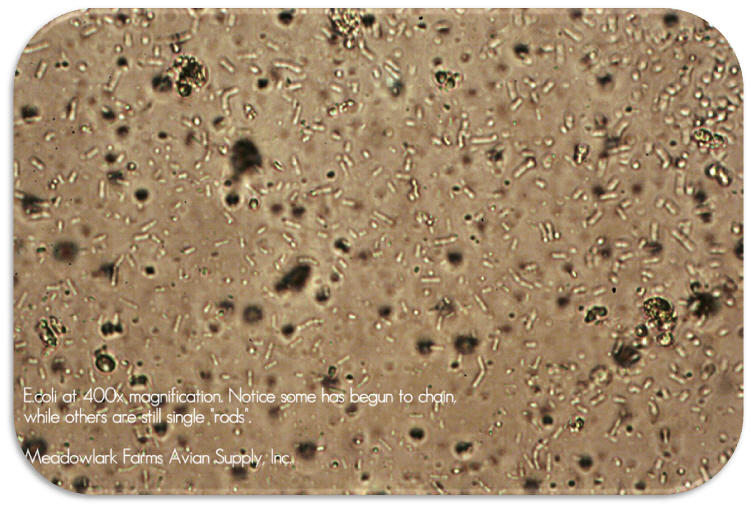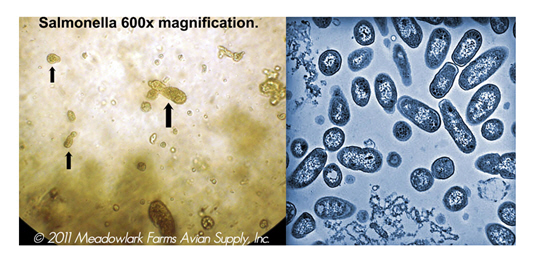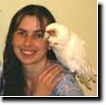Bacterial Infections in Gouldians
& Other Finches
Kristen Reeves, Meadowlark Farms Avian Supply, Inc.
Many of these diseases have very similar causes and symptoms and can apply to all Exotic Finches - not just Gouldians. Treating with the wrong medication can complicate matters, or even make things worse! If you suspect your bird may be ill with one of these diseases, contact your Avian Veterinarian for verification BEFORE administering any medication! Do not use any medication discussed here without first having your bird(s) checked by your Veterinarian! The results could be deadly! The issues discussed here are, in our experience, those most commonly seen in the aviary.
ORNITHOSIS/PSITTACOSIS
This is a serious disease that affects many bird species, including Gouldian finches. Ornithosis typically indicates this kind of infection in passerines (finches), while Psittacosis indicates an infection in psittacines (parrots). It is caused by Chlamydia (a rickettsia-like organism), an intracellular disease, that without special precautions can be spread to humans through contact with infected feces and bodily fluids. It spreads easily throughout the flock, especially when cages and accessories are not kept clean or when overcrowded (poor animal husbandry practices). When birds pick at food and bedding on the bottom of the cage, they sometimes pick up bits of feces, ingesting it and becoming ill with the disease. Keeping cages clean and with a minimal number of birds per cage can keep the chances of getting and spreading this disease low, but once it is in the aviary it cannot be cured.
Once your bird or birds are diagnosed with ornithosis, they will be considered carriers for the remainder of their lives and should not be paired or bred in order to prevent the spread. Some Veterinarians may even recommend euthanasia.
While this infection can affect any of the Gouldian colors, Mutation Gouldians are more susceptible to ornithosis due to weaker genes.
Symptoms can vary, often making it hard to diagnose without the aid of an Avian Veterinarian. Droppings may be watery and are usually greenish. Birds may sit fluffed, sneeze a lot or scratch at their faces. They may also have a runny nose. They may sit fluffed up and motionless with their head tucked and even a leg tucked up. Eye infections are not uncommon with this disease. Birds may sit with eyes at “half mast” as if they are sleepy. Poor breeding results combined with other symptoms may be an indicator. If you are finding your birds won't come into breeding condition, you are finding clear eggs in the nest, or they fall out of condition soon after courting begins, have your birds tested by an Avian Veterinarian.
If the disease has progressed long enough, the bird may begin having trouble standing. This usually only happens when the bird is near death. Psittacosis/Ornithosis (Chlamydia) is usually treated with a ~cycline type antibiotic. Doxycycline or Chlortetracycline are usually prescribed.
STREPTOCOCCUS/STAPYLOCOCCUS
Strep and Staph are cocci (spherical shaped) bacteria. Again, Strep and/or Staph infections are often the result of poor animal husbandry practices.

Strep presents in dropping samples as “chaining” circles. I usually seem them chain with 4 or more objects. They don’t usually jitter in place, but occasionally the background bacteria activity will make them appear to move. Strep can be BOTH gram negative AND gram positive depending on strain.
Usually with Strep, there will be what I refer to as “sheaves of wheat” formations in the dropping samples. Gout, which sometimes presents with similar symptoms, will often rule out staph/strep with the presence of oxalate crystals in the fecal samples.
Staph presents in dropping samples as “clustered” circles. I usually see them in clusters of 5 or more, and they often look like a bunch of grapes jittering in place on the slide. Staph is gram positive, meaning it will soak up crystal violet stain. BUT, unless you’ve reached a high level of microscope diagnostic ability, it is very important to have your Avian Veterinarian run cultures to determine the actual strain.
The bird may have a wound that it keeps pecking at that just won't heal. If the disease progresses long enough, septicemia may set in spreading it through the blood stream. Symptoms closely resemble those of Ornithosis and include panting, fluffing, and depression - but may also be the opposite causing excess nervousness and excitability. Birds with prolonged gastrointestinal problems should be screened for staph/strep - in these birds, loss of color in the feathers (a dullness) and extreme weight loss is typically seen. Infected birds may also seize or convulse - this looks very much like a stroke. The joints are often affected and may become swollen and irritated, though you should have your Veterinarian check the bird to rule out Gout.
Because the treatments for Strep/Staph are different than that of Ornithosis, and it is virtually impossible to diagnose without bacterial cultures, it is important to have your bird(s) tested by an Avian Veterinarian before medicating.
~cillin type antibiotics such as penicillin or amoxicillin are usually prescribed for this type of infection, though your Veterinarian may prescribe one of the ~cyclines.
E-COLI
E.coli is a rod-shaped Gram negative (bacteria which do not retain crystal violet dye) bacteria closely related to Salmonella. It can cause diarrhea, inflamed oviduct (which could be a reason for egg binding if it occurs), peritonitis, and pneumonia caused by failing circulation. It may also cause general listlessness. Droppings may be anything from runny and yellow to dark brown and gritty looking. I have seen

E.coli colonies in just about every color and consistency of dropping. In most cases, the bird’s belly will be enlarged and “bumpy” under the skin with obvious outlines of the intestines through the skin of the abdomen. “Clicking” and “tail bobbing” are also common signs of E.coli, so it is important to have your bird checked by a professional. Because clicking noises are often diagnosed as air sac mites, you should know and understand the symptoms of both diseases. Trimethoprim/Sulfa, other sulphonamides, and occasionally Amoxicillin are usually prescribed for this type of infection.
SALMONELLA
There are several strains of salmonella, but only a few of them are ever seen in caged birds - all of which can be transmitted to humans.

A salmonella outbreak can be transmitted through the egg shell from infected parent birds to the growing embryos causing dead-in-shell chicks. It may be a result of spoiled food (wet foods such as egg food and sprouts), poor husbandry practices, or the presence of rodents and their droppings in the aviary. Infected birds from an outside source (such as a new addition to the aviary) can also transmit this disease to your flock.
Symptoms typically show up in chicks and young juveniles and the observance of dead-in-shell chicks. It is transmitted from infected parents to their young through the feeding process. Chicks may be small and fail to thrive.
“Wet Nest” is often caused by salmonella as the chicks foul the nest with loose, wet droppings. Hens may have a wet belly indicating wet droppings in the chicks. Increased thirst is often seen in the parent birds. Droppings may be watery yellow, green or pale. Grey or blood tinged droppings are sometimes seen. “Wet Vent” is also a potential sign of salmonella, but not always.
Salmonella is another bacterial infection diagnosed through bacterial cultures, but may also be determined through necropsy (as can the other bacterial issues). If the bacteria is well established, your Veterinarian may recommend euthanasia. Treatment takes time and great care must be taken to follow medication directions to the letter. If your Veterinarian recommends follow-up treatments, be sure to mark your calendar for start and finish, then re-treat dates. Furazolidone, Spectomycin, and Sulphonamides are usually prescribed.
A FINAL WORD...
I cannot stress enough the importance of good hygiene and animal husbandry practices. All of these bacterial issues can usually be avoided with proper habits. Because these are all transmittable to humans - and in some cases reportable to the CDC - it is imperative that you wash your hands before and after handling your sick bird, and each time you handle a different bird. The average bird keeper does not have the lab equipment or expertise to determine the actual bacteria involved. If your bird is showing signs of any of these bacterial infections, it is imperative you get them to an Avian Veterinarian for diagnosis and treatment. Failure to do so could result in your own illness as well as the demise of your entire flock! The use of the wrong medication at the wrong time can make matters worse. It is therefore extremely important to know which bacteria you are dealing with and which medication is the best to use BEFORE attempting to treat. A Veterinarian is the only one who can tell you!





